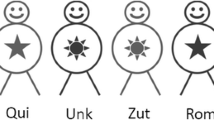Abstract
The current research investigated whether intraverbals would emerge following auditory tact instruction. Participants were first taught to tact auditory stimuli by providing the name of the item or animal that produces the sound (e.g., saying “eagle” when presented with the recording of an eagle cawing). Following test probes for simple intraverbals as well as intraverbal categorization participants were taught to tact what each auditory stimulus is (e.g., saying “caw” when presented with the recording of an eagle cawing). Following both tact instructional phases, the effects of an auditory imagining instruction procedure on target intraverbals were examined. Results indicate that following both tact instructional phases, intraverbals increased for three of four participants. Auditory imagining instruction was sufficient for two of four participants to reach mastery criterion, and two of four participants needed some direct instruction. Low covariation between simple intraverbal and categorization was also observed. Functional interdependence between tacts and intraverbals and the possible role of a conditioned hearing response are discussed.


Similar content being viewed by others
References
Carp, C. L., & Petursdottir, A. (2012). Effects of two training conditions on the emergence of novel intraverbals: an extension of Pérez-González et al. (2008). The Psychological Record, 62, 187–206.
Esch, J. W., Esch, B. E., McCart, J. D., & Petursdottir, A. (2010). An assessment of self-echoic behavior in young children. The Analysis of Verbal Behavior, 26, 3–13.
Grannan, L., & Rehfeldt, R. A. (2012). Emergent intraverbal responses via tact and match-to-sample instruction. Journal of Applied Behavior Analysis, 45, 601–605. doi:10.1901/jaba.2012.45-601.
Hayes, S. C., Barnes-Holmes, D., & Roche, B. (2001). Relational frame theory: a post-Skinnerian account of human language and cognition. New York: Kluwer Academic/Plenum Publishers.
Horner, R. D., & Baer, D. M. (1978). Multiple-probe technique: a variation of the multiple baseline. Journal of Applied Behavior Analysis, 11, 189–196. doi:10.1901/jaba.1978.11-189.
Kisamore, A. N., Carr, J. E., & LeBlanc, L. A. (2011). Training preschool children to use visual imagining as a problem-solving strategy for complex categorization tasks. Journal of Applied Behavior Analysis, 44, 255–278. doi:10.1901/jaba.2011.44-255.
Rehfeldt, R. A. (2011). Toward a technology of derived stimulus relations: an analysis of articles published in the Journal of Applied Behavior analysis, 1992-2009. Journal of Applied Behavior Analysis, 44, 109–119. doi:10.1901/jaba.2011.44-109.
Sautter, R. A., & LeBlanc, L. A. (2006). Empirical applications of Skinner’s analysis of verbal behavior with humans. The Analysis of Verbal Behavior, 22, 35–48.
Sautter, R. A., LeBlanc, L. A., Jay, A. A., Goldsmith, T. R., & Carr, J. E. (2011). The role of problem solving in complex intraverbal repertories. Journal of Applied Behavior Analysis, 44, 227–244. doi:10.1901/jaba.2011.44-227.
Schlinger, H. D. (2009). Auditory imagining. European Journal of Behavior Analysis, 10, 77–85.
Skinner, B. F. (1953). Science & human behavior. New York: Free Press.
Skinner, B. F. (1957). Verbal behavior. Cambridge: Prentice Hall.
Skinner, B. F. (1968). The technology of teaching. New York: Appleton.
Author information
Authors and Affiliations
Corresponding authors
Additional information
Author Note
James R. Mellor is now at the Department of Psychology at Texas Christian University. This article is based on a master’s thesis by the first author and supervised by the third author that was submitted to the Behavior Analysis and Therapy department at Southern Illinois University. We thank committee members Dr. Jonathan C. Baker, Dr. Joel Ringdahl, and Dr. Sandie Bass-Ringdahl for their helpful comments. We also thank Anna Crumpecker, Lilith Reuter-Yuill, Angelica Aguirre, Brittany L. Byrne, Hannah Buck, and Kari L. Colwell for their assistance and support throughout the completion of this study.
Appendix A
Appendix A
Auditory Imagining Script for Stimulus Set 2
If someone asks me a question, and I don’t know the answer I try to talk myself through it. For example if someone asks me what sound a car makes, I would say to myself ‘what other sounds do I know;
I know that an Eagle goes, [Eagle cawing], right an eagle goes caw,
I know that a Toad goes, [Toad croaking], right a toad goes croak,
I know that a Cricket goes, [Cricket chirping], right a Cricket goes chirp chirp,
I know that a Campfire goes, [campfire crackle], right a campfire goes crackle,
I know that Wind goes, [wind whoosh], right wind goes whoosh,
I know that a Computer mouse goes, [CM click], right a computer mouse goes click,
I know that Keys goes, [Keys jingling], right keys go jingle,
I know that a Clock tower goes, [CT ding dong], right a clock tower goes ding dong,
I know that an Alarm goes, [Alarm buzz], right an alarm goes buzz,
And I know that a Tambourine goes, [Tambourine rattle], right a tambourine goes rattle.
Rights and permissions
About this article
Cite this article
Mellor, J.R., Barnes, C.S. & Rehfeldt, R.A. The Effects of Auditory Tact and Auditory Imagining Instructions on the Emergence of Novel Intraverbals. Analysis Verbal Behav 31, 236–254 (2015). https://doi.org/10.1007/s40616-015-0036-0
Published:
Issue Date:
DOI: https://doi.org/10.1007/s40616-015-0036-0




